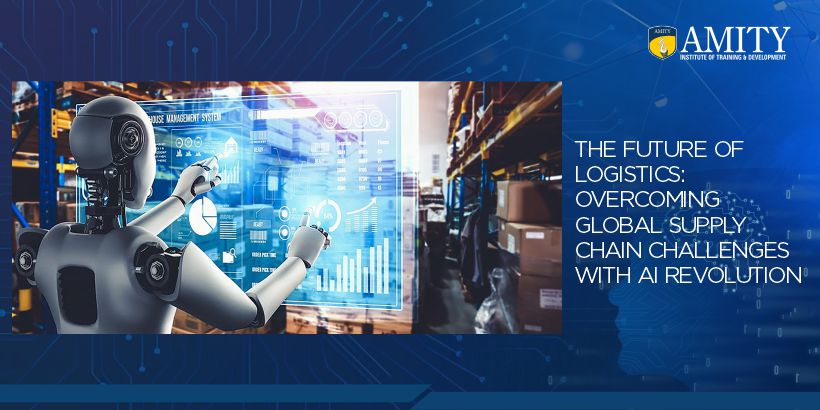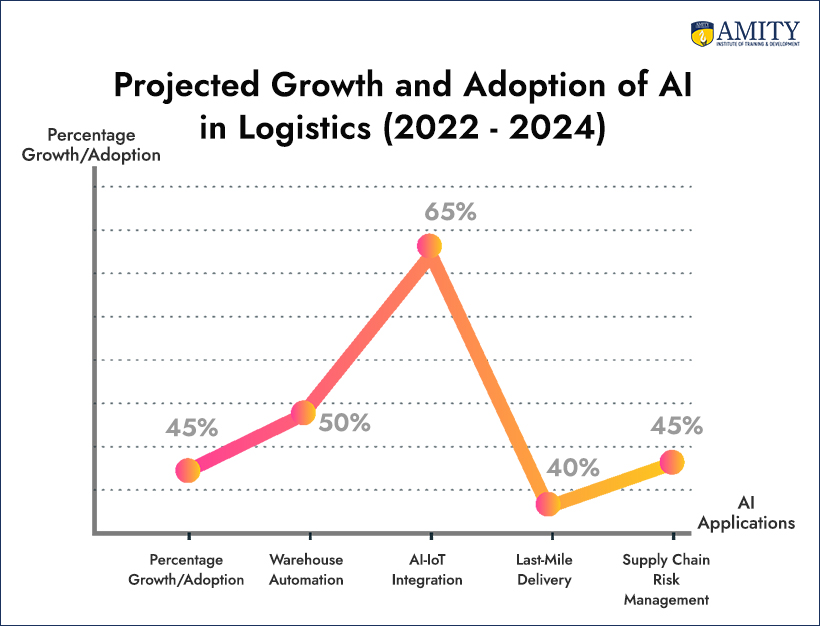Tech-Driven Solutions

This is where the logistics industry is now standing on the brink of a huge change very substantial one AI and automation, which promises to unlock the gateway to meeting the challenges of the global supply chain of tomorrow as the landscape looks toward evolving patterns of what people buy and what they expect.
According to the studies, 56% of logistics firms consider AI to be a major part of their digital change. The companies are assured that AI is going to revolutionize the way they will work and serve their customers. By using AI, the companies can make things faster, cheaper, and more accurate for their success.
The sector will also undergo massive growth in employment opportunities in logistics and supply chain management to meet the new needs. With a growth rate of over 14.08 trillion USD by 2028, the future of logistics is full of new chances for growth and green practices.
This blog discusses the future of logistics, mainly by talking about the way AI and automation are changing it. It backs its points with interesting stats and trends.
Key Takeaways
- AI technology advancements have a lot to offer to the future of logistics.
- Sustainability is coming to play an increasingly important role in setting the rules of the game in logistics practices.
- Changing future patterns of the logistics business demands agile practices and innovative solutions that meet changing consumer demands.
- Demand for skilled professionals continues to rise in logistics and supply chain management jobs.
- Such training from organizations like AITD are essential and necessary because these help in inculcating the skills that are expected to be used in the industry now.
- To stay competitive in the world markets, companies should adopt digital transformation
What is the Future of Logistics?
The future logistics will be based on AI and automation. The companies opt for such technologies for making the supply chain more visible, creating value for customers, and reducing costs. AI helps track shipments in real time, predict demand, and run systems 24/7 without getting tired.
DO YOU KNOW? Logistics will be green in 2030. By then, companies are expected to use zero-emission vehicles and circular supply chains. Sustainability is included in the training offered by AITD.
Future Logistics Trends and Statistics: A Comprehensive Overview

(Source: Adecco group)
The future of logistics is bright, and big growth is expected in the industry. The global logistics market is expected to hit above $14 trillion by 2028. The increased growth in the market is mainly because of more online shopping and changing consumer habits.
| Trend | Statistic |
| AI Market Growth | Expected to reach approximately $549 billion by 2033, growing from $12 billion in 2023. |
| Automation Adoption | About 50% of logistics companies plan to automate their warehouses by 2024. |
| Predictive Analytics Usage | Approximately 45% of firms will utilize AI for risk fortification by end of 2024. |
| Cybersecurity Measures | More than 70% of AI platforms will feature advanced security by 2024. |
These stats show how urgent it is for logistics companies to invest in tech and training to stay competitive.
Do you Know? The demand for skilled labor in Logistics is growing due to labor shortages from rising E-Commerce activities. Training programs offered by AITD would be necessary in order to keep the individuals abreast of skills that may help it survive the changing job markets.
Shifting Patterns in the Future of the Logistics Industry: What You Need to Know
What people want is exactly the direction the logistics industry takes. Speed in delivery and fast shipping are keys that have increased with online shopping. Companies getting up with these changes will be ahead.
1. Increased Demand for Speed
- Consumers Are Demanding Rapid Deliveries: Today, people want their orders as fast as they can be delivered. This has led to making logistics companies better and faster than before.
- Impact on Logistics Operations: To fulfill this requirement, businesses are now implementing new technologies and upgrading of systems. Companies are developing automated warehouses and employing software for the optimal route to be devised for delivery.
2. Focus on Sustainability
- Prioritizing Environmentally Friendly Practices: Companies are focusing on making sustainability their number one priority. Companies go green by using eco-friendly packaging, electric vehicles, and circular supply chain practices.
- Long-Term Benefits: Being environmentally friendly fulfills only the needs of environment-sensitive customers. In the long run, it saves money
3. Use of Technology
- Implementation of AI and Automation Technologies: AI and automation form the core for better working. It helps manage stock, routes, and even customer satisfaction
- Real-Time Data Analysis: Companies use data analytics to know what customers are asking for. That helps the companies take speedy, intelligent decisions.

(Source: DC velocity)
DO YOU KNOW? By the end of 2024, nearly about 45% of logistics firms are likely to use AI in risk-proofing their supply chains.
Logistics vs Supply Chain Management: AI as a Game Changer in Supply Chain Management
AI is essential in solving logistic-related problems. It aids in the optimization of routes and management of warehouses. For example, AI can determine the shortest route for deliveries due to considerations of traffic patterns and weather conditions.
This will save time in deliveries and fuel. For any delivery in the future, it has to be timely and efficient.
(Source: serogroup)
DO YOU KNOW? Some 34% of shipping and logistics firms do not have a digital strategy in place. This gap presents a significant opportunity for those willing to invest in digital transformation.
AI also makes supply chain visibility better by giving real-time updates on inventory and shipments. This lets the companies deal with issues quickly, keeping their operations smooth. The companies who use AI are better at dealing with these challenges.
AI is critical to the solution of supply chain problems that affect the rest of the world since it increases visibility, speed, and efficiency in the following ways:
1. Automation
AI automates work such as data entry and other work pertinent to inventory management. In this way, errors are reduced and made faster. Freeing up firms from routine jobs leaves them free to identify ways to strategize on growth.
2. Predictive Analytics
Demand Forecasting. AI applies the trends in previous data to estimate future demand and therefore handles inventory correctly. This means businesses are aware of changing future trends in logistics, which they act on in a timely manner.
3. Route Optimization
AI determines the optimal routes to follow by analyzing real-time traffic and weather conditions. It saves costs and reduces time taken to deliver. It is an essential requirement to keep competitive.
4. Inventory Management
It automates inventory tracking and order fulfillment, hence making them better. It boosts accuracy and ensures the companies meet customer needs within the shortest time possible. It, therefore, enhances overall service quality.
The future of logistics looks bright with AI. It is what is driving innovation and making supply chains more efficient. Businesses that remain updated with new demands and tech will stay ahead. Investing in training like what Amity Institute of Training & Development (AITD) offers will help keep the workers up.

(Source: IJIS)
During 2024, one of the AI in logistics studies tittle”AI Applications for Improving Transportation and Logistics Operations”was seen to provide very significant elevations. AI enhances supply chain efficiency and reliability as well as planful activity. AITD supports demand forecasting, routing of deliveries, cost minimization, and service improvement.
How AITD Can Help Shape the Future of Logistics Training?
AITD is an integral part of the logistics formation process. It is in the best position to enable its practitioners with skills for the future. New trends and tech are changing at a rapid pace.
Logistics and Supply Chain Management Jobs: Key Areas of Focus for AITD

1. Development Of Digital Skills
Digital skills form a core part of AITD, including AI, data analytics, and automation. Some of the most prominent skills relating to the future of logistics revolve around AI. AI will handle mundane, time-consuming tasks, allowing professionals to create strategies.
2. Leadership Development
Logistics leaders of the future will be dealing with completely different environments. AITD delivers training for leadership readying them to face these differences. They will be prepared to work with new technology, among other things, and work under a worldwide team.
3. Sustainable Practices
Sustainability is now very important in logistics. AITD trains the companies on how to be green. Companies that care about sustainability will flourish in the future.
Future of the Logistics Industry and Statistics: AITD’s Response to Emerging Trends
1. Emerging Technology Workshops
AITD offers seminars and workshops on AI in Logistics. It gives an explanation of the fact that how AI makes operations better. AI is important for the future of logistics, making tasks more efficient and judgments better.
2. Research-Driven Insights
AITD understands deep research and understanding of logistics trends. It provides insights into developing smart strategies for logistics. This includes market growth and tech development.
3. Development of Future Skills Required
The logistics industry is changing, so are the skills. AITD emphasizes data analytics and supply chain optimization skills that will be most valuable in helping you make better decisions and improve operations. AI and IoT are going to play a major role in those changes.

Did You Know? More than 10,000 professionals have benefited by training through AITD, so you can stay ahead of the curve.
Embracing Change toward a Sustainable Future: How AITD Equips You for Industry Shifts
Logistics has entered a phase where growth occurs at a double-digit rate. Changes in consumer demand and new technologies in the market bring various challenges to such industries. Thus, all resources should be utilized to know the trends and maintain a competitive edge in such changing scenarios. Training and development will be the vital initiative that helps to face challenges and grow sustainably in logistics.







